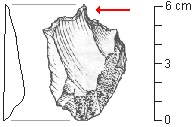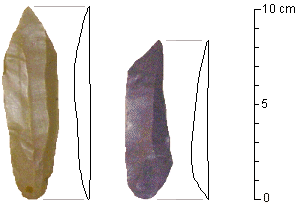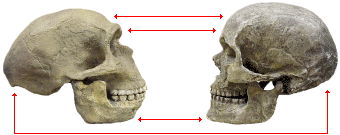
Stone Tools
Neanderthals were known to use close-up weapons when hunting. They would stalk their prey practically touching them before going in for the kill. Many of the remains found of the Neanderthals had very bad injuries resembling that of a modern day bullfighter (8). Their tools were characterized by a technique known as Mousterian. It involved the use of flakes to be removed and added to other tools from a single stone (24). They used this technique in mastering the sharp-edge technique. Neanderthals were known to use their tools not only for hunting, but also to clean animal hide and to create clothing, of which the Neanderthals were the first to invent this. The tools created by the Neanderthals proved to be just as efficient, even slightly more powerful in their cutting ability and also their durability, as the tools created by early Homo sapiens (32). This was proven by the disk flakes of the Neanderthals, which wasted less rocks, suffered less breaks, and actually had a more of a cutting edge compared to the straight blades of early Homo sapiens (33). After creating spear points, in order to attach it to their weapons, Neanderthals would use adhesives such as resin or tar to stick the spear points onto wooden shafts(20). Neanderthals were the first in creating sewing needles, responding to being the first species to wear clothes in order to deal with the harsh cold climate that they lived in. They would use stone aws or otherwise known as borers to punch holes into the animal hide in order for them to sew (24). The Neanderthals were pioneering many tools, developing based on what they needed to survive. Their tools were the first to have multiple parts, otherwise known as composite tools (10). This gave way to far more lethal weapons that were much more difficult for an animal to overcome. Here are some of the many tools used by Neanderthals throughout their existence.








The image to the left represents early neanderthal blades. As you can see from the ruller on the side, the blades were twice as long compared to the flakes. The blades could function as knives, drills, or even spear tips (14).
The image above represents many of the different types and forms of the Neanderthal Blades and Flakes. The flakes are located towards the top of the image, while the blades are located along the bottom (14).
The image to the left reprsent some of the oldest examples of a kind of bone tool called a lissoir, that the Neanderthals may have crafted. They were used to smooth out some of the hides they had in order to make those hides tougher. The lissior you see to the right were found at a Neanderthal excavation site of Abri Peyrony in Europe (29).
This picture represents the Mousterian tradition of Neanderthals. The image on the left is of a unifacial scraper, while the image on right represents a spear point (24).
The image above gives us a glimpse into the many type of tools used by the Neanderthals. In the picture you can, in order from top left to top right, a chopping tool, flake-blade core, notched scraper, and a nucleus in the shape of a hand axe. From the bottom left to the bottom right, you can see a utilized flake, end scraper, retouched broken blade, and a scraper (20).
This image represents a Neanderthals stone awl or borer. It was used to punch or drill holes in softer materials such as leather and wood (24). As you can see from the image the awl had sort of a birdlike beak or projection protruding from the top.
